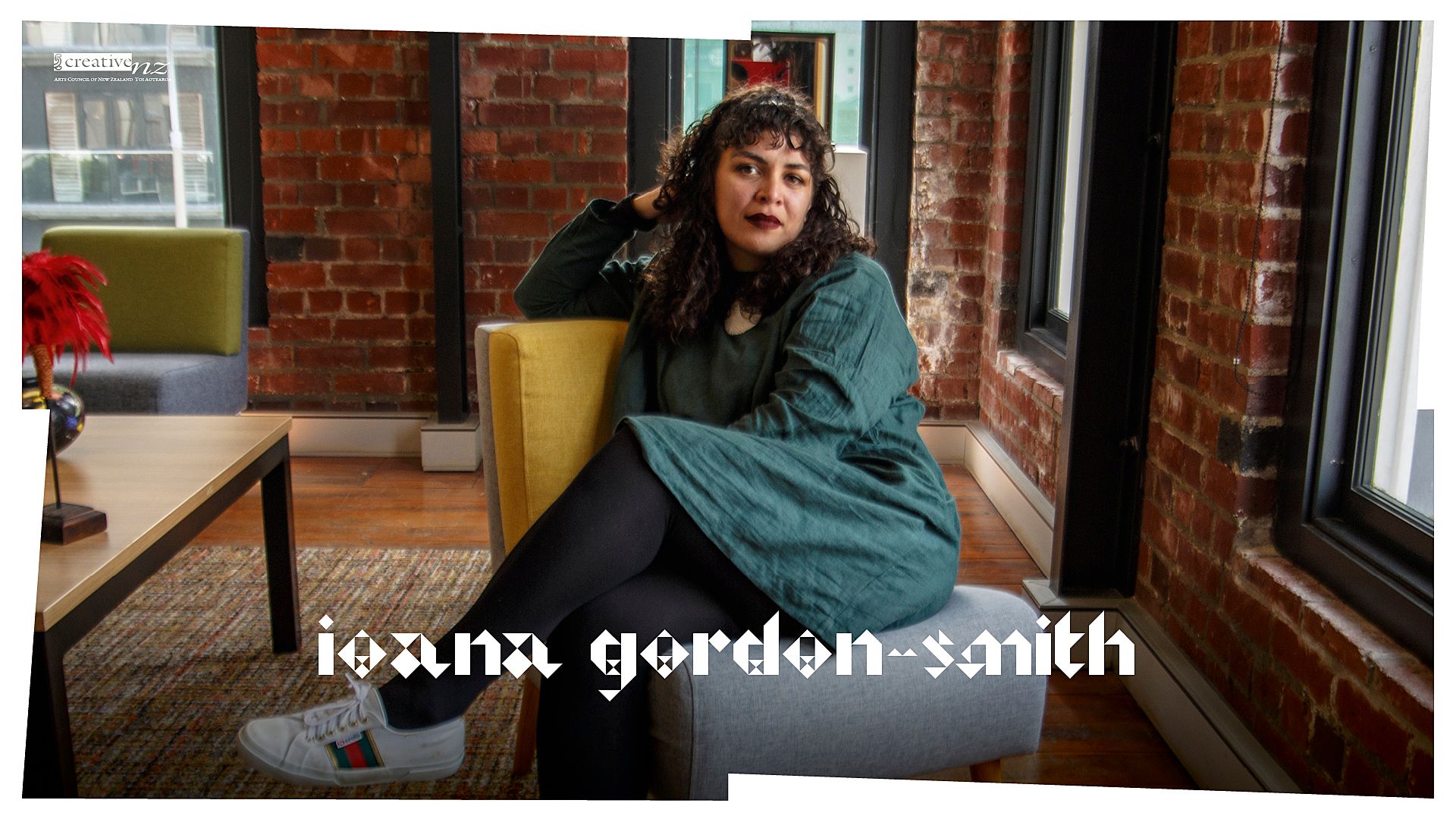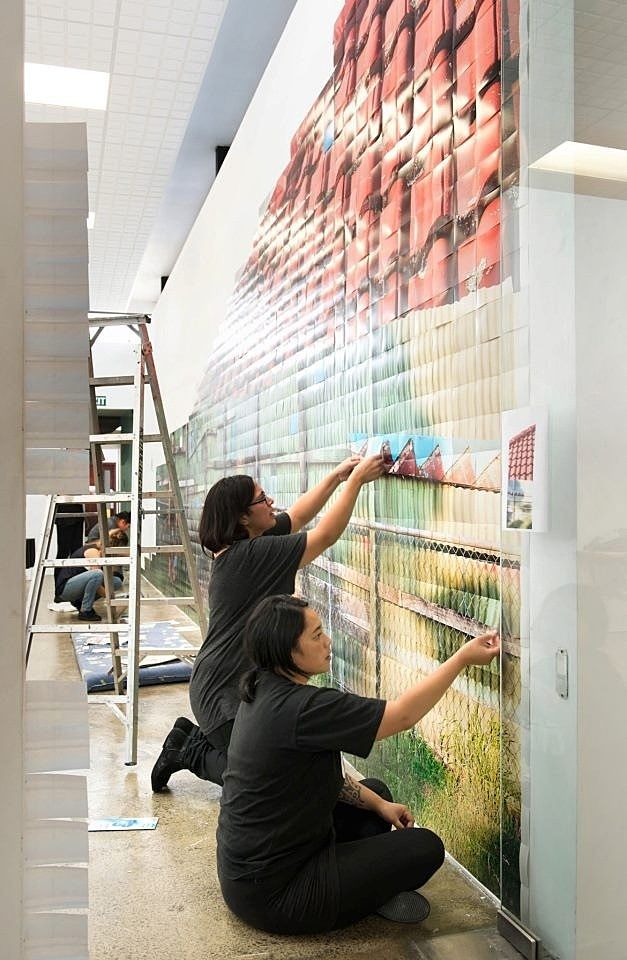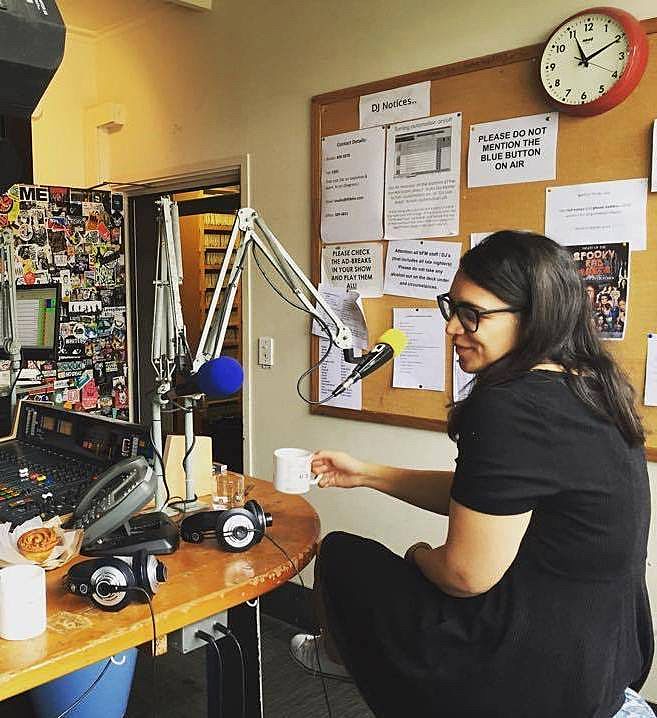Trojan Horses: Internships and Entering the Art Pipeline
Curatorial roles are rarely filled by Pasifika arts workers. Ioana Gordon-Smith reflects on being a guinea pig of sorts, building relationships and the legacy of Trojan horses, I mean internships.
We’re collaborating with Creative New Zealand to bring you the groundbreaking Pacific Arts Legacy Project. Curated by Lana Lopesi as project Editor-in-Chief, it’s a foundational history of Pacific arts in Aotearoa as told from the perspective of the artists who were there.
The experiment began in 2013. Artspace Aotearoa, together with Tautai Contemporary Pacific Arts Trust (Tautai), had just launched a new internship. A call-out was placed for “the first of three Education Internships focused on connecting students and young people with the most exciting artists and their creations of challenging and inspiring contemporary art.”
The internship emerged from a new Creative New Zealand (CNZ) Sector Investment Development Fund, available solely to CNZ investment clients but with a preference for applications that established partnerships between clients. An opportunity for Artspace and Tautai to collaborate presented itself. Artspace was responding to the accelerating gentrification of Karangahape Road and the perception of Artspace as disconnected from its (historically) brown neighbouring community. Tautai was committed to supporting art students. A tertiary programme comprising Fresh Horizons workshops and the Tertiary Graduate Exhibition was Tautai’s crowning glory. In an Education Internship, both Artspace’s and Tautai’s needs to connect with a young, Moana audience coincided.
As a new initiative, the internship programme was very much a pilot. It was the first outcome of the new Sector Development Fund, the first partnership between Tautai and Artspace, and, as far as I can tell, the first time Artspace hired an employee of Moana heritage.
I was thrilled to be selected as the guinea pig.
*
The first email I sent from my new Artspace email address took almost an hour to compose. I remember complaining to Artspace’s Administrative Manager at the time, Anna Gardner, about it. Not the email itself, but the length of time it took to write. You don’t have a mental database of prior emails to draw from, she reassured me. Over time, shorthand, go-to-phrases, a sense of how much nicety needs to be included, would become a habit.
I was already working at Objectspace part-time during my internship, so not everything about an art gallery was new. Nevertheless, for that first internship week, I wasn’t sure what to do. I was there four days a week, but without any allocated tasks or projects. I was eager not to annoy Artspace’s small, over-performing team, who were already accumulating more TOIL (time off in lieu) than they could ever claim back. Consequently, I spent most of my first week scouring the server. I read Anthony Byrt’s MA thesis on Artspace. I read through the catalogues of past shows. Mostly, I tried not to get in the way while wondering what exactly the work of an Education Intern entailed. I’m not sure I know better today.
You had carte blanche to design whatever you liked
The internship’s stated aim to “develop a tailored education programme at Artspace, actively encouraging the involvement of local primary, secondary and tertiary schools” was somewhat limited by the nine-month internship, as most primary and secondary schools needed more lead-in time. I recall visiting Te Tuhi and Auckland Art Gallery Toi o Tāmaki to speak with their educators but, to be honest, their programmes were so well established with long-term structures and relationships that I couldn’t figure out anything to replicate at Artspace. Possibly it was during those chats I started making up education PDFs for teachers about upcoming exhibitions. It was a useful exercise in discussing art concepts and references in accessible language; a new practice for me, having only written essays for university.
We were lucky during my internship to host the 5th Auckland Triennial (which proved to also be the last), for which Artspace was one of the multiple sites. Janet Lilo was the sole Aotearoa New Zealand artist to have work at Artspace. It was a timely overlap. Working from a specifically Auckland (Avondale) context, using a mix of familiar objects and methods, Janet’s work offered a useful way to engage local audiences in an exhibition programme otherwise featuring international projects. The Triennial also offered a useful way to get to know Janet herself. I remember regular phone calls from Janet, who became something of a self-appointed mentor during the internship. In a workplace that respected relationships as methodology, receiving a call specifically for me in an open-plan office was the first thing that made me feel legit.
There is otherwise a massive gap in my memory between not being sure what to do and coming up with projects. The Education Internship was in all ways – deliberate and otherwise – geared towards self-organisation. I recall seeing KPIs at some point, but they might have been along the lines of ‘stage ten events’, or something similar. As an entirely new role at Artspace, there was no precedent to build upon. It’s a daunting prospect to step into a vacuum, something that 2015 Education Internship recipient Louisa Afoa and I have reflected on elsewhere. You had carte blanche to design whatever you liked; conversely, no one was going to tell you what to do. This opportunity was probably better maximised as the internships were repeated, with new learnings gained over each iteration.
There was a sense of a Moana takeover, even if it was short lived
During my internship, we ran three main projects. The first was a regular writing group for Moana writers. Shamefully, the recruiting of the participants was ad hoc. Being new to Tāmaki Makaurau, I mostly relied on Tautai’s recommendations of people to shoulder tap. Eventually, the group settled into six participants: Louisa Afoa, Natasha Matila-Smith, Lana Lopesi, Amiria Puia-Taylor, Talia Smith and Candace Weir. Each workshop, I’d invite a different guest writer to lead the session: Ema Tavola, Daniel Satele, Tessa Laird and Jon Bywater. Artspace and Tautai coproduced a publication featuring a final text from each of the participants. Each essay was printed as its own folded handout, with the idea that they could be collected and bound together as a set. For many of us, it was the first publication we could put on our CV.
Two of the participants, Natasha Matila-Smith and Amiria Puia-Taylor, crossed over into a second project, In the Neighbourhood. Working with youth-development organisation Ngā Rangatahi Toa, the aim was to pair selected rangatahi with artist mentors. The project was in part driven by the pragmatic need to circumnavigate the school system, one already overburdened and unable to commit to gallery initiatives. One of the hardest things was just trying to find rangatahi interested in joining a random art project. Partnerships were vital, but even with Ngā Rangatahi Toa on board, we still struggled to attract participants. In the end, we had three rangatahi and four artist mentors. Over a week, the pairings worked together at Whitespace, with a one-night event opening held on the final evening. Some of the final artist videos, captured by artist mentor Grant Apiata, are still on Facebook.
The final project was curating the fifth iteration of Offstage, an annual Tautai event showcasing Moana moving image and performance. Presented as a one-night event, it had previously been staged at Galatos. Presenting Offstage at Artspace felt like a big deal. Previous iterations emphasised a ‘screening reel’ approach. Moving-image works were limited to five minutes and performances to ten minutes. Offstage 5 took more of an exhibition approach. Works sprawled throughout the main galleries. The event was replete with all the ‘signifiers’ associated with an exhibition: an opening, commissioned install shots, an artists talk. The opening was packed (to me at least). In attendance were not just obliging Artspace board members, but Moana artists, their friends and their families. There was a sense of a Moana takeover, even if it was short lived.
Sione Faletau performance during 'Offstage'. Image courtesy of the artist.
In recent years, internships have blossomed across arts organisations in Aotearoa. Various programmes are now run by Dunedin Public Art Gallery, Adam Art Gallery, Te Tuhi Centre for the Arts, and the long-standing Blumhardt/CNZ internship at The Dowse Art Museum has continued strong. A recent Overland Journal article astutely observes that part of the need for internships in most professions comes from the lack of training provided within jobs. Instead, interviewers favour applicants who, beyond degree qualifications, already exemplify ‘job readiness’. This bias towards experience is amplified in the competitive GLAM (galleries, libraries, archives and museums) sector, which endures slim employment prospects. Any vacancy usually results in a musical-chairs reshuffle, rather than new blood entering the force. In a 2018 article surveying independent curating, writer Scott Indrisek observes that a boom in museum studies, specialised graduate programmes in curating and art-administration degrees exacerbates the paucity of jobs available.
The role of internships is especially pertinent for Moana arts workers. As New York Times reporter Robin Pogrebin notes, “People of color have had difficulty entering the pipeline, facing barriers that include exclusion from informal mentoring networks, resistance to alternative perspectives on art history, and financial hurdles: many entry-level internships are unpaid.” In the simple act of offering a paid gig, the Education Internship paved a way to enter the industry.
There’s little doubt that the Tautai/Artspace Education Internship carried CV value in subsequent job interviews. The internship connects me to the Artspace brand; one that carries clout nationally and is perceived as conceptually daring and rigorous. But I’d argue that the CV value of the Education Internship was secondary to the relationships formed during that time. Curating is often understood as dependent upon knowledge of current practice and its discourses. The artists you know of and know personally function as a type of intellectual and social capital respectively. At Artspace, even just sitting in the office would expose you to artists dropping by for a chat or coffee.
At Artspace, even just sitting in the office would expose you to artists dropping by for a chat or coffee
While the internship brought me into Artspace’s existing artist community, there was also a sense that the internship was supposed to develop a new network for Artspace. The original call for applicants, for instance, noted that the role “will be preferably awarded to a candidate who has strong ties within the Pacific community.” The internship then also acted as a way of, on the cheap, broadening Artspace’s radar. Most spaces are now thirsty for diverse programming, pressured by greater attention to a lack of representation, but the relationships aren’t there. The internships have arguably increased a Moana presence at Artspace. Over the course of subsequent internships, for example, Offstage became a semi-regular part of Artspace’s programme. It was curated again by Louisa Afoa for Artspace in 2015, and by Cameron Ah Loo-Matamua in 2017, each time increasing in its duration and budget.
As a pilot programme, any outcomes must have been seen as a win. But the desired effects from the Education Internship were perhaps not as simple or immediately satisfied as a better CV for the interns, or more Moana audiences or artists at Artspace. Over lunch, Creative New Zealand Arts Practice Director – Pacific, Makerita Urale, spoke of the importance of throwing Moana creatives into potential collision. Placing Moana art workers in proximity to arts organisations, artists and funding was all in the hope of sparking some elusive connection or idea that might manifest years or decades into the future, that would benefit the Moana arts at large.
The stated education aims of the internship were more like a Trojan horse
This long-term investment in Moana arts is perhaps more obvious in the way CNZ has invested in other, intern-like programmes. Running parallel to the Education Internship was Tautai’s Pasifika (then renamed Oceania) Internships Programme. Tautai would select interns and then work to place them within a wide range of arts organisations, spanning theatre, television, museums and design studios. Later, when I worked as Curator at Te Uru Waitākere Contemporary Gallery, we would take on two interns. With a wider remit of potential institutional partners, the internships shared with the Artspace/Tautai Education Internship the same aim of placing Moana arts workers within arts organisations to develop art managers and administrators. Similarly, CNZ recently partnered with Leadership NZ to support four artists specifically in leadership training.
Though my own experience was framed as an Education Internship, with a view to bringing in young, local Moana audiences, I don’t think the education mandate was really the major focus. Instead, the stated education aims of the internship were more like a Trojan horse. Education fulfilled an obvious institutional and funding purpose, but the internship was really much more simply about bringing a young, Moana arts worker into an arts organisation and seeing what might emerge.
What came from it, for me, was introducing a group of us to each other at a time when galleries didn’t know us at all. Initiating projects required reaching out to strangers and instigating relationships, new processes that felt paralysing but eventually produced connections that flitted between friendly and collegial. Independent curator Vera Mey has described this area between formalised, institutional networks and informal friendships as a place “where a large portion of curatorial and artistic practice seemed to reside, no matter which context or art scene”, but is particularly necessary in unsupportive conditions. Though she writes from a context of political and financial constraint, the necessity to develop and grow this ‘grey area’ felt particularly necessary for Moana artists, who were bursting with ideas about the world but often lacking opportunities to formalise these within gallery spaces.
Ioana and Janet Lilo installing 'Right of Way'. Image courtesy of the artist.
The next few years were full of proposals. Talia and I started a brief-lived curatorial duo (I think Transit Projects still exists as a Facebook page) and successfully pitched for a Tautai-funded exhibition at Papakura Art Gallery and later a street-front presentation of work by Lana Lopesi for the 2015 Whau Arts Festival in Avondale. Lana and I would later work together on the temporary newspaper–publication project Localise, at times commissioning writers who also had some role in the Artspace writing programme, such as Ema Tavola, Louisa Afoa and Local Time (whose members include Jon Bywater). It’s entirely possible that a few subsequent exhibitions during my time at Te Uru working with artists Janet Lilo, Robert George, Natasha Matila-Smith and Tuafale Tanoa’i (aka Linda T) owe some debt to the time I spent building relationships with them during my internship.
There are many more threads, too many to trace, arguably too private to lay bare, certainly too long ago to remember. It’s hard to determine how much of later scheming can be attributed to small, incidental meetings and modest projects over a nine-month period (was it a deliberately gestational timeframe?). But they arguably did something; as behind-the-scenes mastermind Makerita Urale would put it, “sometimes a small nudge is all it takes.” Writing this text, I was saddened to realise that the internship and its projects now fall outside of Artspace’s and Tautai’s website archives. A lasting web of working relationships and projects is probably the main record of that period now.
cnz
This piece is published in collaboration with Creative New Zealand as part of the Pacific Arts Legacy Project, an initiative under Creative New Zealand’s Pacific Arts Strategy. Lana Lopesi is Editor-in-Chief of the project.
Series design by Shaun Naufahu, Alt group.
Header photo by Pati Solomona Tyrell.




